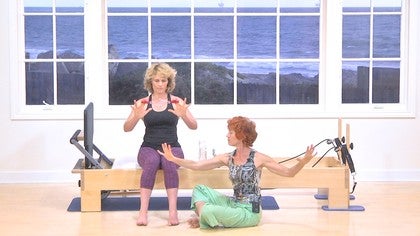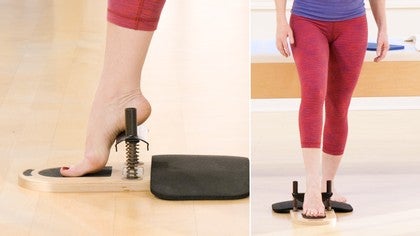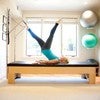Description
About This Video
Transcript
Read Full Transcript
Hi there. This evening what I wanted to do with some tutorials, I'm starting with a toll corrector, which I'm will, we will show how to use four fingers, hands two which is hardly ever done but wonderful to do. Anytime you want to get more sensitivity and intelligence in the legs. Specializing in defining the feed more specifically is helpful before footwork, before jumping board, which is what we're going to do a little bit later on. But for now we're starting with the feet. This is good if you have problems, if you have Bunyan's, if you have aging clients or if you just want more intelligent and powerful feet or healthy feet, it helps separate the toes. So most of us have dead numb, dumb toes.
If I was to say the truth of my opinion about most people's feet, mine included, so what we've done here, by the way, you can use a big fat rubber band that you can buy from staples. Or if you buy Broccoli and you have a thick rubber band round the vegetables, that works really well too. And this is a toe corrector, a grads toe corrector. So we put it around the big toe. Now, Mandy, if you would pull your feet apart and let this stretch your big toe inwards. So keep going out and in. So what she's doing, as she's stretching out, it's allowing the the band or the rubber band to pull and start to loosen up the big toe. The big toe usually gets kind of jammed and stuck and calcified and I can already see that on both feet as she's pulling out her big toe is actually pulling in like it's gotten an abundant tendency. Sometimes I, we don't want that mandate. Keep going and I'm going to not let you do. It's a spread your toes first, spread your toes and now let the foot go apart.
Pause here and I'm actually tractioning her big toe inwards to edit educated. We really want very wide feet. Then come back in and again do the same again and let that, this foot isn't doing it. Being too cooperative. That's okay. Keep going. I said Tozer stupid. So this is like common knowledge. It usually takes a little bit fussing, hold it out.
It takes some fast to kind of teach the toes to do something. They're not used to come back in, press out again. And if you're doing it to yourself, you reach down and make the toe go away. That's better. We want this toll. Yes, no, yeah. I actually want the toe to be traction in the knot. I don't want you to get strong. Yeah. So as you go on my right.
Okay, so spread out and hold and I'm going to try and help you. Yes. Two more times like that. She stopped being stupid. Yeah, it's tricky. They really liked their, these things down at the bottom of the foot that don't do much. Now that starting out, see if you can also spread the toes apart. I'm doing it with my hands to kind of demonstrate what we're trying to achieve here. This separation of the toes.
Keep going back and forth and thought we'll follow energy. We'll follow thoughts. Just having the intention. She starting to work really hard. It's hard, isn't it? Yeah, that's it. Paul and Paul. Now, we will not do this today all the way, but you can actually move if, especially if you're working with a rubber band, you, we won't be able to do it. You can do the same saying moving down the toes. So every time the band is over, we're looking to open up the webbing.
So now she's got these two together and she's pulling apart. Yeah. That's amazing. Now as you do it, I want to also to feel that you're moving all the way. Yes. So you start to activate and wake up the legs and by the way, do foot work. Do this. Go back and do footwork again and you'll see your legs
We're looking to get the toes long now spread apart so the toes are pulling towards each other. Keep the toes pulling up at. Press the ball of the foot down. So you're in a high flex position of the toes and I can feel how tight your big toe joint is. Now keeps spreading and press the toes down towards the floor. Press down, down, down to stretch them at the tarsals and then lift the toes up so you flat.
Yes, you get this full flection of the toe. Keep the toes pulling apart and then flex the foot all the way up. You can bend your knees. So keep going to your, this band is pulling you apart. You press down, press the toes down, lift the toes up, spreading. Flex your feet all the way, all the way, all the way up. And again, press down. I wanted to see this pulling apart. Yes. Press down, toes towards the floor. Keep spreading that spring.
Pull it apart to forces your toes to be wide. Lift the toes up and flex your feet two more times like this. This is good. See how much nicer, more detail is coming into the whole foot. Press down. I want this toe to stay in. Pull down, lift the toe up and flex your feet and flex. Your knees. Might just as well get, make the whole leg work. And one more time.
I'm going to get the heels apart as well. Press down all five joints. Press the toe down. Nice Mandy. Lift the toe up and flex your feet all the way up. Very, very good. Now if you have a Bunyan, which you just have the beginnings of, you can either keep one foot, if you put, put this and lift your knee up and whole behind your knee with your hand.
So you're pulling the traction of the spring is up. You can also do this. I'll take the foot out. You can hold the spring with your hand. Now this is very individual because if you have a Bunyan, you want to traction out so that you're pulling the joint out and then you just pull the big toe joint down. So you press the toe joint down and lift the big toe joint up and you're working the toe against. That's a press down.
And if the toe up and press down, I want the knee now straight and up. Let's get this foot a little bit more out. That's it. Press down. But Mandy, you need to pull, no, not the foot. The Toe. Yes, that's it. So that you're, you're not letting the Bunyan pattern work. You're forcing the joint to remember how to move in a right alignment. And it's quite amazing how much, much. Um, sometimes it can be calcium deposits.
Sometimes the joint is a little rusty a lot. This is like wd 40. Yes. Look how much better the joint is working and the big toe has its own fulcrum of a work. Make sure, see if you can keep yourself straight it and it's a big stabilizer. The other four toes work with a different balance of muscles from the big toe. So often people lose that stabilize of the big toe. This looks good.
Let's have you do the other side. It feels really good and nice. So out. So lots of the foot long. Remember you're tracking this joint out and long and then you pulling the big toe down and up against resistance. How far away you have the foot that's working is up to you. You can be sitting.
I know some people like to work the other foot up and then you work your big toe down and up. You just training that big toe to do work. Just like my thumb is pressing down and lifting up. So you're exercising your big toe.
I'm going to help it down and up. You've got the idea with the angle, so she's pulling out because her toe wants to go in two more times. Mandy, down, down, down, down and up.
Just stretch your thumbs away from the center so you use it a stretch of time, so in and out a few times.
And then, yeah,
And then the ring finger,
Uh, that's it. So you pull apart. But no, this has to be a Pi. Okay. Uh, to join. So another way to play with this. So you'll pull that. So you feel how it's stretching the whole inside. It's like you're taking the fingers and you're pulling them back.
So those are two ways to work into the fingers. And one more, make sure both hands are pulling away from each other. And now do the same with the little finger. Just a way, because the little finger will not work the same way. It's got nothing to pull away from when you're pulling it into yes. All the way up into my shoulders.
I can see it working all the way into your shoulders. Oh my goodness.
So we will pull this apart to help you. Yes. So not just go up and down and work your fingers. That's it. Three and four have a go with the next fingers. So yeah, we go into one hand at a time and again, one, two, three, four. PyLadies is for everything. Hi, good. I will pull it apart. So you can go ring finger. Whoops.
One, two. This is, these are archival exercises with the toe corrector. We don't really do them and they are very, very sophisticated work into the extremities. Yeah. And let's have you do the last one. Yes. Two.
It's cause I'm so strong right. Here we are. Okay. So here we are.
The toe of toe corrector is a wonderful tool to use. Very great for the hands. If you don't have one for the hat, just use a rubber band and use a ball for the contracting part. Very therapeutic way. Or do use,
Pilates for Dancers: Foot-Focused Classes
Comments
As well as my feets!
 Thanks Niedra!
Thanks Niedra!
You need to be a subscriber to post a comment.
Please Log In or Create an Account to start your free trial.

















